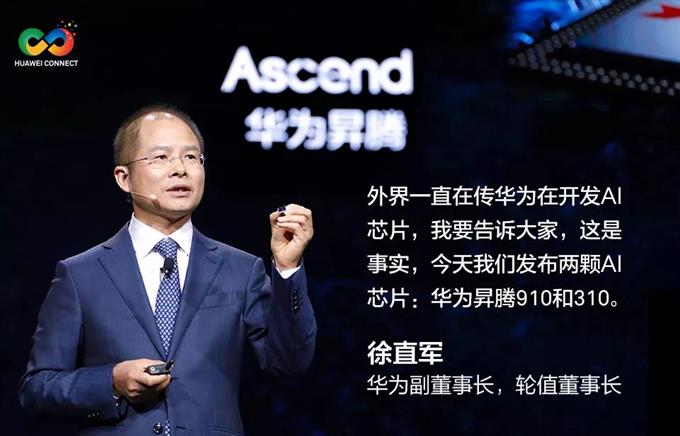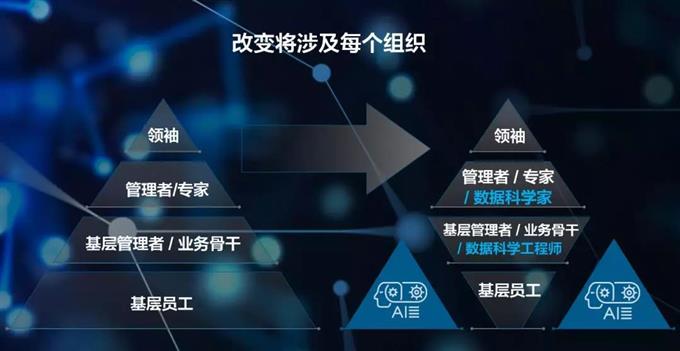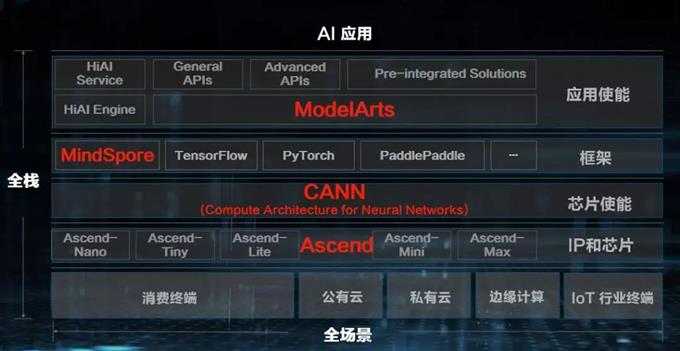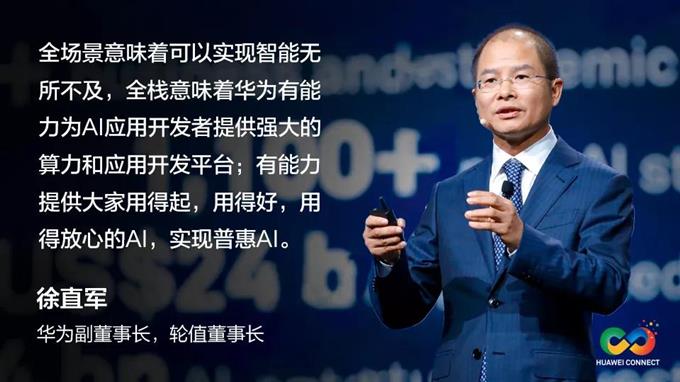Date:2018-10-26
The third Huawei Full Connect Conference was grandly opened on October 10th at the Shanghai World Expo Exhibition Hall and World Expo Center. Huawei's rotating chairman Xu Zhijun delivered a keynote speech at the conference, systematically expounding Huawei's AI development strategy and full-stack full-scenario AI solutions, including the world's first Ascend series IP and chips that cover full-scenario artificial intelligence.

The main points of Mr. Xu Zhijun’s speech are as follows:
AI is the total result of 60 years of development of the ICT industry
In 1956, John McCarthy, then assistant professor at Dartmouth College, organized a Dartmouth discussion. It was at this meeting that the definition of "artificial intelligence" was formally proposed for the first time. In the 60 years since then, artificial intelligence has experienced two lows in its development, the so-called "winter", but its development has not stopped there.
In 1971, Intel released the first microprocessor. For more than 50 years, Moore's Law has witnessed the vigorous development of the ICT industry.

If we draw the 60-year development trajectory of the AI industry and the ICT industry together, it should roughly look like the picture. In a nutshell, artificial intelligence is closely related to the overall development level of the ICT industry, and academic research findings and engineering technology development complement each other.
The two "winters" of the AI industry are all because the society's expectations for AI applications have greatly exceeded the development reality of the ICT industry's engineering level. Fortunately, "winter" is not the end, but the beginning of every "spring".
Today, we have once again entered the "harvest" season. This is the result of long-term hard work and mutual cooperation between the global ICT academia and industry over the past 60 years.
Facing the future, we should make full use of artificial intelligence technology, pay close attention to the harvest, and strive to expand the harvest. At the same time, we must make the harvest season last longer and build artificial intelligence (AI) on the equator, which will always be vibrant.
Artificial intelligence is a new general purpose technology
Any technology can only give full play to its value if it is accurately positioned. Reasonable positioning of artificial intelligence technology is the basis for our understanding and application of this technology.
Like wheels and iron in BC, railways and electricity in the 19th century, and automobiles, computers, and the Internet in the 20th century, Huawei agrees that artificial intelligence is a collection of technologies and a new general purpose technology (GPT).
Canadian scholar Richard G Lipsey proposed in his book "Economic Transformation: General Technology and Long-term Economic Growth" that the sustainable development of the social economy is continuously promoted by the continuous emergence of general technology. The so-called general technology, simple understanding is to have multiple uses, apply to almost all places in the economy, and have huge technological complementarity and spillover effects.
Economists believe that human beings have developed to today, there are a total of 26 general technologies, and artificial intelligence is one of them.
The reason why I emphasize that artificial intelligence is a general-purpose technology is to hope that everyone will pay attention to the great influence and value of artificial intelligence in the future. As a general technology, artificial intelligence not only enables us to solve the solved problems with higher efficiency, but also solves many unsolved problems.
Whether we have true artificial intelligence thinking and whether we can solve current and future problems with artificial intelligence concepts and technologies is the key to whether we can build leading competitiveness in the future.
Huawei has found in practice that artificial intelligence can not only replace humans, but also automatically reduce production costs. This is the biggest difference between artificial intelligence and informatization, and it is also its most valuable feature.
Artificial intelligence will change every industry and every organization
Industrial changes triggered by artificial intelligence will involve all industries. Every one of us here must think about whether my industry will be changed by artificial intelligence technology, or even completely subverted. How to reconstruct the respective industries and enterprises in a brand-new model is what we will think and practice in the future.

Today, we can clearly predict that artificial intelligence will change or subvert the following industries:
Smart transportation will greatly improve traffic efficiency
Personalized education will significantly improve the efficiency of teachers and students
Precise preventive treatment is expected to extend human life
Real-time multi-language translation and communication without barriers
Precision drug testing can significantly reduce the cost of new drugs and shorten the discovery cycle
The operation and maintenance efficiency of AI-based telecom networks will be greatly improved
Autonomous driving and electric vehicles will disrupt the automotive industry, etc.
In just one year since the release of Huawei Cloud EI and HiAI, we have deeply felt the unprecedented upsurge.
In addition to the changes brought about by the industry, artificial intelligence will also change every organization. Each of the previous technological revolutions since the 18th century will have a huge impact on the organization's structure, operating procedures, and personnel capabilities.
From the perspective of job positions and personnel capabilities, there will be an obvious difference in artificial intelligence driving this change: past changes will always generate a large number of repetitive daily work requirements, such as equipment operation in textile factories, automobile manufacturing lines, and mobile phone manufacturing. Pipeline, etc.
But artificial intelligence will improve the level of automation in almost every aspect, so the demand for a large number of repetitive jobs will be greatly reduced. At the same time, there is a need to increase the demand for data science jobs, such as data scientists, data science engineers with general data science capabilities, and so on. The number of these positions will be far less than the current repetitive daily jobs.
Therefore, we believe that the composition of the future organization may be diamond-shaped, and a large number of basic and repetitive daily positions at the bottom will be replaced by AI.
Change has just begun, choosing the right problem is more important than finding novel solutions
In fact, the various changes triggered by artificial intelligence have just begun. Changes have always been the joys and sorrows of several families, especially at the beginning of the change.
We may be excited by witnessing that AI realizes a certain function that we would never have imagined before, and thus have the urge to accelerate the widespread adoption of AI. It may also be anxious because an AI project is not progressing as expected or worrying about the safety and reliability of AI applications, which may cause confusion about how to use AI in the future.
From the historical development of all general purpose technologies, these are normal phenomena.
We have just passed the partial exploration stage of AI technology and application, and we are currently in the second stage. At this stage, from a technical perspective, on the one hand, AI technology is becoming more and more perfect, while at the same time more and more problems are exposed; from an application perspective, on the one hand, the application of AI is becoming more extensive and the value continues to be confirmed, but at the same time, the policy environment, The company's processes and organizational personnel are mainly oriented to the past technologies, such as the technology of the information technology and the Internet age. They have not yet prepared for the arrival of the intelligent technology era, so collisions and even conflicts often occur.
AI technology will eventually win its own social environment. At that time, we will move towards the third stage of comprehensive and rapid development of AI applications and productivity enhancement.
Before ushering in the new GPT technology, we will continue to witness and enjoy this golden development period, the fourth stage. But we must also be soberly aware that artificial intelligence is not omnipotent. Artificial intelligence has problems that it can solve and problems that it cannot solve.
We should fully focus on the problems that artificial intelligence can solve and the areas where it creates value, instead of spending energy on problems that artificial intelligence can’t solve or areas where it can’t create value. Because choosing the right problem is more important than finding novel solutions.
Today we see an exciting gap
A journey of a thousand miles begins with a single step, let’s take a look at the state of artificial intelligence today:
On the one hand, the following series of big numbers let us feel the "brilliance" of the development of the artificial intelligence industry: The number of machine learning papers published in 2017 was 20,000; more than 22 countries around the world have released AI plans; a new one was born in 2017 More than 1,100 AI startup companies; AI-related mergers and acquisitions amounted to US$24 billion in 2017; AI-related VC investment reached US$14 billion in 2017.
On the other hand, the following series of small numbers let us feel the "coolness" of the initial stage of artificial intelligence: only 4% of enterprises have invested or deployed AI; only about 2% of retailers have invested or deployed AI; only About 5% of deployed smart cities are using AI; in 2017, only about 10% of smartphones have built-in AI; the global supply-demand ratio of AI talent is only 1%.
The gap between "brilliant" and "calm" is condensing a huge driving force for industrial development. The so-called "mountain rain is about to come and wind is all over the building", this kind of gap is exciting.
Ten major changes to create the future
To resolve the huge gap between the "brilliance" and "calmness" of artificial intelligence, and to create the future, we need to make active changes in the three aspects of technology, talent, and industry. Today, I would like to share with you ten important reform directions related to artificial intelligence technology, talent and industry.

One of the changes: shorten the time to train the model
According to the current technical level, training some complex models often takes days or even months, and successful innovation discovery often requires multiple iterations. This training speed severely restricts application innovation. We believe that the training of future models should be completed within minutes or even seconds.
Change 2: Abundant economic computing power
Computing power is the foundation of AI, but the current computing power is very expensive and a scarce resource. If the progress of computing power is the main driving factor of the current AI development, then the scarcity and expensiveness of computing power are becoming the core factors restricting the overall development of AI.
We believe that computing power should be abundant and economical, and this demand should be realized as soon as possible.
Change three: artificial intelligence needs to adapt to any deployment scenario
Hybrid cloud has become the main mode for enterprises to adopt cloud services. The current AI is mainly in the cloud, with a small amount at the edge. The integration with the business environment of the enterprise needs to be further deepened.
We believe that AI will be ubiquitous in the future, and it must be able to be deployed in any scenario and ensure that user privacy is respected and protected.
Change four: more efficient and safer algorithms
Algorithms are another major driving force for the development of AI, but most of the main algorithms currently used were born in the 1980s. With the widespread popularity of AI, the deficiencies of these algorithms have become more and more obvious.
We believe that future algorithms should be able to be based on fewer data requirements, that is, data efficiency. It must also be based on lower computing power and energy consumption, that is, energy efficient. At the same time, it is necessary to solve its own security problems and realize interpretability... etc. These are important technical foundations for the all-round development of AI.
Change 5: Higher level of automation
Today's artificial intelligence requires a lot of manpower by itself, especially in the data tagging process. Today, a new profession called "data tagger" has even been born. Someone ridiculed that today's artificial intelligence, there is no "intelligence" without "manpower".
We believe that the automation level of AI itself should be greatly improved. For example, in data labeling, data acquisition, feature extraction, model design and training, etc., it should be automated or semi-automated.
Change 6: The model should be oriented to practical applications
In June 2018, Benjamin, an assistant professor at the University of Berkeley and others, published a paper with a strange title-"Can the CIFAR-10 classifier be generalized to CIFAR-10? 》
The paper pointed out that the model algorithm with excellent accuracy was tested on the CIFAR-10 classifier, but there was a deviation on another test set created by the author very close to CIFAR-10, and the classification and recognition accuracy dropped by 5-15. The percentage points vary. This also means that the availability of this model algorithm has dropped drastically.
From this, it can be seen that many of the current excellent model algorithms are more excellent in "exams" and have not yet reached "work" excellence.
We believe that the future model must achieve industrial-level excellence, that is, meet the needs of industrial production, and not just be satisfied with the "exam" excellence on the test set.
Change 7: Model update
The accuracy of the model is not static, but will change with the data distribution, application environment, and hardware environment. It is necessary for enterprise applications to always maintain the accuracy within the expected range. However, the current model update is non-real-time and relies on manual periodic update, so it is a semi-open loop system.
We believe that future models must be able to adapt to various changes in time, update them in real time, and implement a closed-loop system to ensure that enterprise AI applications are always in the best state.
Change 8: Artificial intelligence requires multi-technology collaboration
Every general-purpose technology can only be fully coordinated with other technologies in order to maximize its performance and create huge economic value. AI is no exception, but when we are currently discussing AI, we focus more on AI itself.
We believe that AI needs to be fully coordinated with technologies such as cloud, Internet of Things, edge computing, blockchain, big data, databases... etc. in order to achieve greater value.
Change 9: Artificial Intelligence must become a basic skill supported by a one-stop platform
Today, AI is still a job that only experts with advanced skills can complete. Mature, stable, and complete automation tools are still lacking. Obtaining an AI model is still a very complicated, time-consuming and labor-intensive task.
We believe that there should be a one-stop platform that provides the necessary automation tools to make AI application development easier and faster. As a result, AI has become a basic skill for all application developers and even all ICT technology practitioners.
Change ten: Use AI thinking to solve the shortage of AI talents
The shortage of AI talents, especially the shortage of data scientists, has always been a restrictive factor that the industry has more concerns about. And we believe that data scientists will always be scarce.
The solution should be to solve the shortage of AI talents with AI thinking. By focusing on the development of intelligent, automated, easy-to-use AI platforms and tool services, as well as providing training and education, train a large number of data science engineers so that they can complete a large number of basic data science-related tasks.
Through these trapezoidal structures where a large number of data science engineers, data scientists and experts in various fields cooperate with each other, the problem of scarcity of AI talents can be solved.
These ten changes are certainly not all of the development of AI technology, talents, and industry, but they are all important foundations for future development.
Huawei's AI development strategy
These ten major changes are not only Huawei's expectations for the development of the AI industry, but also the driving force behind Huawei's AI development strategy. Based on these ten major changes, Huawei’s AI development strategy includes five aspects:
Fundamental research on investment: Build data-efficient (less data requirements), energy-efficient (lower computing power and energy consumption), safe, reliable, and autonomous machine learning in areas such as computational vision, natural language processing, decision-making reasoning, etc. Basic ability
Create a full-stack solution: create a full-stack, independent, collaborative, and full-stack solution for cloud, edge, and end scenarios, providing ample and economical computing resources, easy-to-use, high-efficiency, and full-process AI platform
Investment and open ecology and talent training: Facing the world, continue to cooperate extensively with academia, industry and industry partners to create an open artificial intelligence ecology and cultivate artificial intelligence talents
Solution enhancement: Introduce AI thinking and technology into existing products and services to achieve greater value and stronger competitiveness
Internal efficiency improvement: AI is used to optimize internal management, aiming at a large number of operating scenarios, and greatly improving the efficiency and quality of internal operations
Huawei's AI solution

This picture is Huawei's full-stack full-scenario AI solution.
The full scenario we propose refers to deployment environments including public clouds, private clouds, various edge computing, IoT industry terminals, and consumer terminals.
The full stack we are talking about is a technical functional perspective, which refers to a full stack solution including chips, chip enablement, training and inference frameworks, and application enablement.
Huawei's full-stack solution specifically includes:
Ascend: Serialized AIIP and chips based on a unified and scalable architecture, including five series including Max, Mini, Lite, Tiny and Nano. Including the Huawei Ascend 910 (Ascend 910) we released today, the AI chip with the highest single-chip computing density that has been released in the world, and the Ascend 310, which is currently the AI SoC with the strongest computing power for edge computing scenarios.
CANN: Chip operator library and highly automated operator development tool
MindSpore: A unified training and reasoning framework that supports end, edge, and cloud independent and collaborative training
Application enablement: provide full-process services (ModelArts), layered API and pre-integrated solutions
In April 2018, Huawei released HiAI, an artificial intelligence engine for smart terminals;
In September 2017, Huawei released Huawei Cloud EI, an artificial intelligence service platform for enterprises and governments.
Today, the full-stack, full-scenario solution we released is a strong support for Huawei Cloud EI and HiAI. Based on this solution, Huawei Cloud EI can provide full-stack artificial intelligence solutions for enterprises and governments; HiAI can provide full-stack solutions for smart terminals, and HiAIservice is deployed based on Huawei Cloud EI.
In general, Huawei's artificial intelligence development strategy is based on continuous investment in basic research and AI talent training, creating full-stack, full-scenario AI solutions and opening up the global ecosystem.
Facing Huawei, continue to explore and support internal management optimization and efficiency improvement
Facing telecom operators, promote the efficiency of operation and maintenance through SoftCOM AI
For consumers, through HiAI, let the terminal from smart to smart
For enterprises and governments, through HUAWEI CLOUD EI public cloud service and FusionMind private cloud solution, provide all organizations with sufficient economic computing power and enable them to make good use of AI
At the same time, we also provide AI accelerator cards, AI servers, all-in-one machines and other products open to the whole society.

The full scenario that we propose means that Huawei has the ability to achieve intelligent omnipotence and build an intelligent world with all things connected.
The full stack means that Huawei has the ability to provide AI application developers with powerful computing power and application development platforms; it has the ability to provide affordable, well-used, and safe-to-use AI to achieve inclusive AI.
Finally, thank you all for coming to the Full Connect Conference. Huawei hopes to work together with everyone here to make artificial intelligence no longer above the top, but towards the general public. Huawei hopes to work with customers, industry partners, academia, etc., to achieve win-win cooperation, create an all-encompassing AI, and build an intelligent world with all things connected!